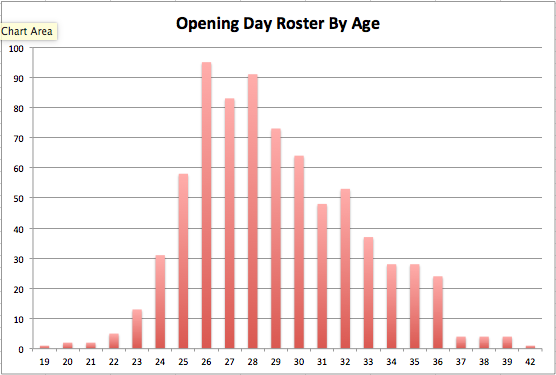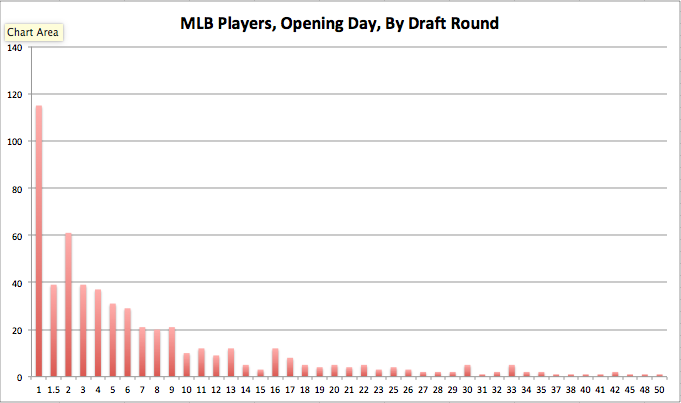2019 MLB Opening Day Rosters By The Numbers


Image credit: Members of the New York Mets and Washington Nationals line the baselines as they listen to the playing of the national anthem on Opening Day at Nationals Park on March 28, 2019 in Washington, DC. (Photo by Patrick McDermott/Getty Images)
Opening Day is a snapshot. In reality it’s no different and no more important than any of the other 161 games. But it’s a useful snapshot as we look at where major leaguers come from and how they get to the majors.
Here’s the story of 2019 MLB Opening Day roster composition.
1. Rangers, Cardinals Produce The Most Big Leaguers
Teams can be built a variety of ways, but when it comes to drafting or signing big leaguers, the Texas Rangers lead the way with 41 players they initially signed on Opening Day rosters. The Cardinals follow with 36 MLB players. The Red Sox (31), Mets (30) and Yankees (30) are the only other teams with 30 or more big leaguers.
The Cardinals have the most draftees (29) while the Rangers are the best at signing future big leaguers on the international market (15).
The Brewers and Athletics are at the bottom of the barrel with 18 players apiece they drafted/signed on Opening Day rosters.
The Nationals win the most improved award. In 2016, there were no international signees from the Nats in the major leagues on Opening Day. This year, the Nationals have six international signees
The complete run down is included below.
| Team | DRAFT | INTL | OTHER | Total |
| Rangers | 26 | 15 | 41 | |
| Cardinals | 29 | 7 | 36 | |
| Red Sox | 20 | 10 | 1 | 31 |
| Mets | 21 | 9 | 30 | |
| Yankees | 20 | 10 | 30 | |
| Braves | 18 | 10 | 1 | 29 |
| Padres | 24 | 4 | 28 | |
| Rays | 19 | 7 | 2 | 28 |
| Cubs | 15 | 11 | 26 | |
| Diamondbacks | 20 | 6 | 26 | |
| Dodgers | 16 | 10 | 26 | |
| Mariners | 15 | 11 | 26 | |
| Pirates | 23 | 3 | 26 | |
| Nationals | 19 | 6 | 25 | |
| Royals | 23 | 2 | 25 | |
| Angels | 19 | 4 | 1 | 24 |
| Astros | 19 | 5 | 24 | |
| Rockies | 19 | 5 | 24 | |
| Blue Jays | 19 | 4 | 23 | |
| Marlins | 18 | 4 | 1 | 23 |
| Orioles | 19 | 3 | 22 | |
| Tigers | 16 | 5 | 1 | 22 |
| Phillies | 12 | 9 | 21 | |
| Giants | 14 | 6 | 20 | |
| Twins | 13 | 6 | 1 | 20 |
| Indians | 12 | 7 | 19 | |
| Reds | 15 | 4 | 19 | |
| White Sox | 14 | 5 | 19 | |
| Athletics | 16 | 2 | 18 | |
| Brewers | 16 | 2 | 18 |
2. There’s Still Room For Thirtysomethings
Baseball keeps getting younger, but there are still plenty of players in their 30s on Opening Day rosters — 31 percent of MLB players are 31 or older. The cliff right now occurs when players go from 36 to 37. While there are 28 players who are 34, 28 who are 35 and 24 who are 36, there are only four 37-year-olds and only 13 players 37-years-old or older.

3. The Oldest And The Youngest
Here are the 10 oldest players in the majors.
- Athletics: Fernando Rodney, RHP (42)
- Angels: Albert Pujols, 1B (39)
- Giants: Erik Kratz, C (39)
- Twins: Nelson Cruz, DH (39)
- Phillies: Pat Neshek, RHP (39)
- Marlins: Curtis Granderson, OF (38)
- Cubs: Ben Zobrist, 2B (38)
- Indians: Oliver Perez, LHP (38).
- Cardinals: Adam Wainwright, RHP (38)
- Padres: Ian Kinsler, 2B (37)
And the 10 youngest:
- Blue Jays: Elvis Luciano, RHP (19)
- Padres: Fernando Tatis, SS (20)
- Nationals: Juan Soto, OF (20)
- Braves: Bryse Wilson, RHP (21)
- Braves: Ronald Acuna, OF (21)
- Nationals: Victor Robles, OF (22)
- Braves: Ozzie Albies, 2B (22)
- Yankees: Gleyber Torres, 2B (22)
- White Sox: Eloy Jimenez, OF (22)
- Red Sox: Rafael Devers, 3B (22)
3. Scouts Know What They’re Doing
Everyone knows scouting is a difficult profession. But looked at in the aggregate, teams do a very solid job of lining up talent. Nearly 40 percent of draftees on Opening Day rosters were drafted in the first, supplemental first or second round.
There is a slight uptick in MLB players drafted in the 11th and 13th round (under the current draft format, teams often draft senior signs in the ninth and 10th round and then spend larger amounts on 11th, 12th and 13th round picks), but generally the distribution of draftees shows a steady slope.
The 24th round is the first round to fail to produce a big leaguer on Opening Day rosters. The 36th and 39th rounds are the only other rounds from the top 40 rounds that don’t have current big leaguers.
Outfielder Jarrod Dyson is the latest round pick on an Opening Day roster. As a 50th-rounder, he represents a round that has long since been eliminated from the draft.

4. Paths To The Big Leagues Are Narrowing
In 2016 when we studied Opening Day rosters, there were seven nondrafted free agents on rosters and there were six in 2017. This year, there are only five. That number may keep dropping as Braves RHP Wes Parsons and Tigers RHP Joe Jimenez are the only NDFAs under the age of 30. They are joined by RHPs Kirby Yates, Matt Shoemaker and D.J. Johnson as the NDFA representatives.
There are also three independent league players on rosters. The Marlins (Trevor Richards), Red Sox (Chris Martin) and Twins (Nick Anderson) are the three teams to find big leaguers in indy ball, although Richards is the only one still playing for his original team.
But those are the only eight players in the majors who weren’t signed international or in the draft. If you’re not picked in the draft, it’s not an easy path to a big league job.
5. Youppi Approves
Even with Bartolo Colon and Brandon Phillips no longer on MLB rosters, there still is one remaining tie to the Montreal Expos. Ian Desmond was the third round pick of the Expos in 2004, the final year before the team moved to Washington, D.C.
6. Where Did They Come From
Of the 549 draftees on Opening Day rosters, 59 percent were drafted out of four-year colleges. High school draftees comprise 33 percent of draftees while eight percent are from junior colleges. Another two did not come from any school.
7. Cal State Fullerton, Long Beach State Represent
Cal State Fullerton and Long Beach State both lead the way with 10 players on Opening Day rosters. Arkansas and Vanderbilt were tied for the third most big leaguers with eight while Missisippi State and North Carolina are the only schools with seven.
The schools with six big leaguers are Arizona State, Florida, Georgia Tech, Kentucky, Louisiana State and South Carolina.
The schools with five big leaguers are Alabama, Arizona, California, Mississippi and Virginia.
Players only count if they were selected for the draft out of that school, so players who transferred are not included, and it only applies to players on active rosters.
8. Which High Schools Stand Out
Our high school data is slightly less robust, as we don’t have high school information for 134 draftees. But of the 415 draftees for whom we have high school information, Elk Grove (Calif.) HS and the Puerto Rico Baseball Academy each have four big league players to top all high schools.
Mets third baseman J.D. Davis, Blue Jays first baseman Rowdy Tellez, Mariners catcher David Freitas and Reds righthander David Hernandez all are Elk Grove alums while Astros shortstop Carlos Correa, Red Sox catcher Christian Vazquez, Tigers righthander Joe Jimenez and Cubs catcher Victor Caratini hail from Puerto Rico Baseball Academy.
9. International Feel
One out of every four players on an active Opening Day roster was signed internationally, which is nearly identical to last year’s numbers. Of those international signees, the Dominican Republic leads the way with 86 players, that’s 14 more than the country had just a year ago. Venezuela has 59 MLB players, five less than last year. Cuba (17) is the only other country with more than 10 big leaguers. Mexico (8) has more players born there than Canada (5) while tiny Curacao, which has only 160,000 population, also has five big leaguers. So does South Korea and Japan.

Comments are closed.